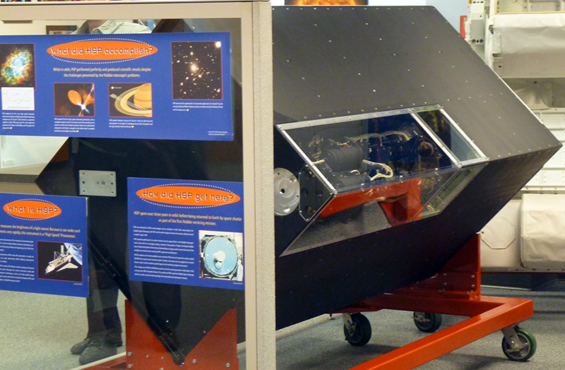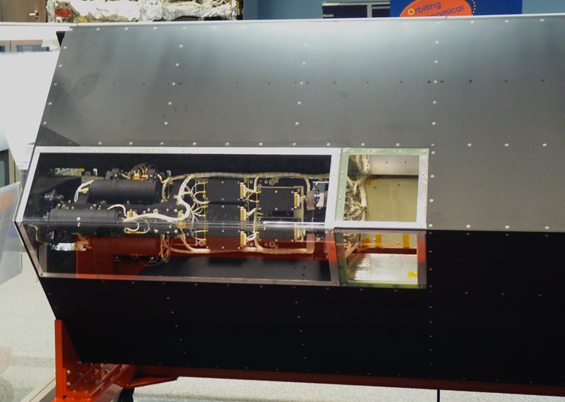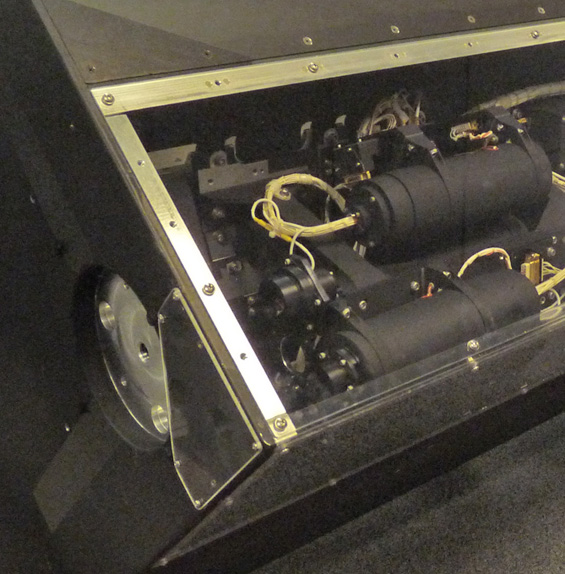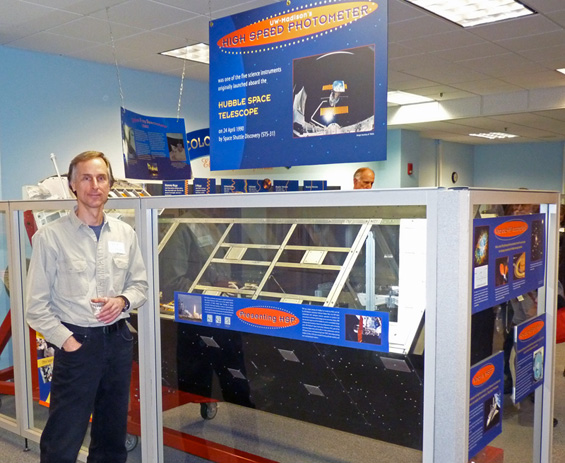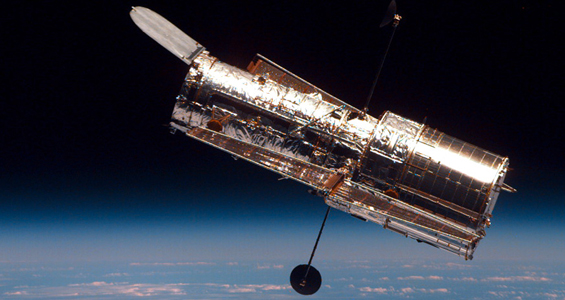Prodigal Satellite Instrument Returns Home
After spending 44 months in orbit and traveling 535 million miles in space, one of the original instruments launched with the Hubble Space Telescope has finally made its way back to its birthplace: Madison, WI.
The High-Speed Photometer (HSP) was designed and built by UW-Madison’s Space Astronomy Laboratory and SSEC. On 24 April 1990 it was launched on the Space Shuttle Discovery as one of the five instrument packages aboard the orbiting telescope.
With the recent retirement of the space shuttle program, the HSP became available for museum display. It took a little detective work for Jim Lattis, Director of the UW-affiliated Space Place, to track down the stored device, but once he found it, he snagged the historic instrument and has put it on display.
The High-Speed Photometer as exhibited at the Space Place
with the optical detector subsystem exposed.
The simplest of the five original scientific instruments on board the Hubble, the photometer measured 3 by 3 by 6 feet and weighed 600 pounds. The HSP consisted of four image dissectors: two sensitive in the UV range and solar blind; the others sensitive in the visible and near infrared. It contained no moving parts, but its detectors measured the brightness of celestial objects at great speed: a rate of one measurement per 10 microseconds. That’s 100,000 samples per second.
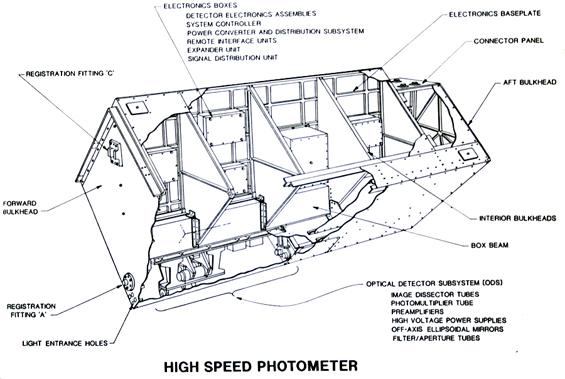
Note that this diagram of the High Speed Photometer is rotated in relation to the photograph above. The optical detector subsystem is at the bottom of the diagram.
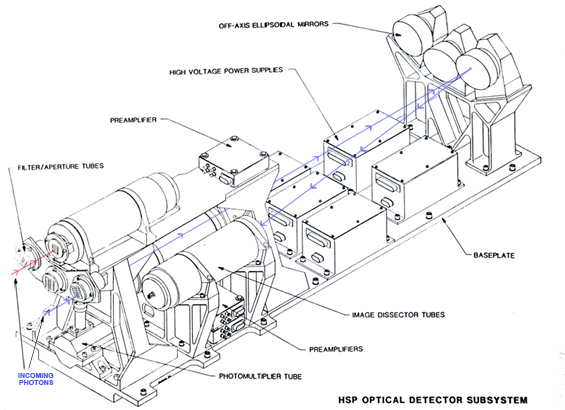
Photons enter the top-mounted Image Dissector Tube directly from the forward light entrance hole.
In the case of the three bottom-mounted Image Dissector Tubes, photons enter via
the Filter/Aperture Tubes and are directed to the Image Dissector Tubes
by the Off-Axis Ellipsodal Mirrors.
Note that this diagram is flipped 180 degrees from the diagram immediately above.
The top Image Dissector Tube in this diagram is mounted closest to the axis of the Space Telescope.
The photometer’s ability to capture light waves at such high speeds enabled it to perform innovative astronomical functions. The HSP probed the detailed structure of Saturn’s rings by observing the interruptions in the light of a background star when the planet and its rings moved in front of the star. The first high speed UV photometry over a complete eruption of a recurrent nova was obtained by the HSP.
A wide variety of bandpasses could be achieved by broadband and interference filters arranged in strips near the focal point of the Hubble’s optics. Apertures provided a choice of three fields of view: 0.4, 1.0, and 10.8 arc-seconds. The dissectors could be commanded to receive photoelectrons from any of the approximately 100 filter-aperture-polarizer combinations available.
Nick Ciganovich, who came to work at SSEC specifically to handle the massive job of drafting the engineering plans, says, “Think of it as a huge light meter, one capable of decoding the signals from rapidly spinning pulsars.”
“In one of the electronics boxes alone, the power supply, there were 165 mechanical parts, in addition to the thousands of electrical components, that had to be designed and constructed,” Ciganovich continues, then smiles. “By my calculations, at the end of the project, I had drawn something like 30 miles of pencil lines. This was all done before computer-aided design systems.”
SSEC supplied the HSP to NASA on schedule, under budget, and 100 pounds lighter than the permitted 700 pound limit. (The extra hundred pounds was donated to another instrument, which had run overweight.)
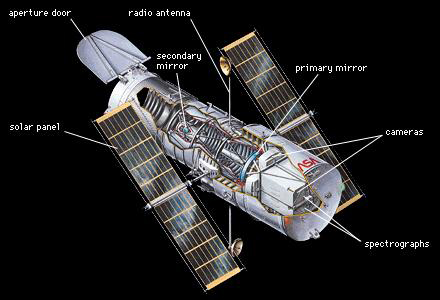
Note the axial science instrument bay (labeled “spectrographs” above right)
where the HSP was installed along with three other packages of identical size and shape.
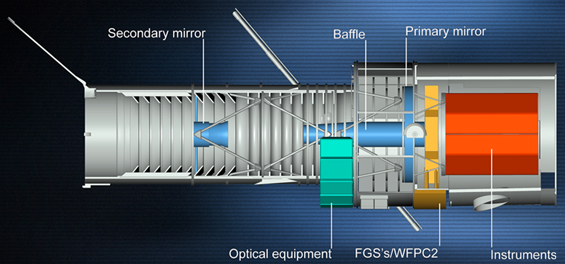
All the instruments are dependent upon the mirror of the telescope
to focus the light on the axially-located focal plane.
The HSP functioned perfectly its entire time in space, but a severe optical flaw in the space telescope’s main mirror severely degraded the results of all of the instruments on Hubble.
The Hubble telescope had to be repaired. In December 1993, astronauts removed the HSP and replaced it with the Corrective Optics Space Telescope Axial Replacement (COSTAR), which corrected the optical problem for the remaining instruments. At the time of the replacement, the HSP was the only instrument on board not to have suffered a failure of a major subsystem.
The Hubble Space Telescope has gone on to produce some of the most important work in the history of astronomy. The HSP came back to Earth, and finally made its way back to Madison.
The Space Place opened the same year that the HSP rode into space in the Hubble Space Telescope. SSEC’s High Speed Photometer has found a new home.
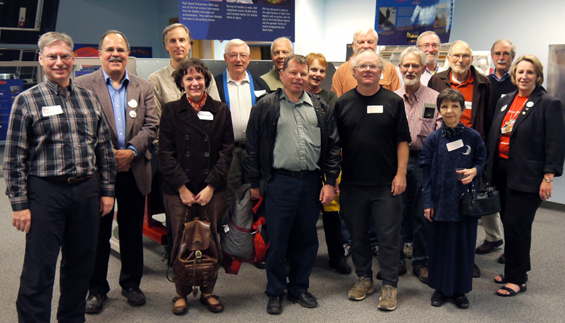
The High-Speed Photometer was designed and built by the UW-Madison Space Astronomy Laboratory and SSEC. Members of the team from both institutions gathered at the Space Place to honor its arrival home. From left to right: Jim Lattis (Director of the Space Place), Terry Devitt, Nick Ciganovich, Jeniffer Lattis, Bob Sutton, Robert Dombrowski, Dave Bridsall, Allisanne Apple, Tony Wendricks, Scott Ellington, Bob Herbsleb, Jeff Percival, Robert Bless, Terry Gregory, Fred Best, Kathy Stittelburg.

